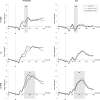What I Say is What I Get: Stronger Effects of Self-Generated vs. Cue-Induced Expectations in Event-Related Potentials
- PMID: 23403896
- PMCID: PMC3565970
- DOI: 10.3389/fpsyg.2012.00562
What I Say is What I Get: Stronger Effects of Self-Generated vs. Cue-Induced Expectations in Event-Related Potentials
Abstract
Expectations regarding future events enable preparatory processes and allow for faster responses to expected stimuli compared to unexpected stimuli. Expectations can have internal sources or follow external cues. While many studies on expectation effects use some form of cueing, a direct comparison with self-generated expectations involving behavioral and psychophysiological measures is lacking. In the present study we compare cue-induced expectations with self-generated expectations that are both expressed verbally in a within-subjects design, measuring behavioral performance, and event-related brain potentials (ERPs). Response time benefits for expected stimuli are much larger when expectations are self-generated as compared to externally cued. Increased amplitudes in both the N2 and P3 components for violations of self-generated expectations suggest that this advantage can at least partially be ascribed to greater perceptual preparation. This goes along with a missing benefit for stimuli matching the expected response only and is mirrored in the lateralized readiness potential (LRP). Taken together, behavioral and ERP findings indicate that self-generated expectations lead to increased premotoric preparation compared to cue-induced expectations. Underlying cognitive or neuronal functional differences between these types of expectation remain a subject for future studies.
Keywords: N2; P3; cue-induced expectations; event-related brain potentials; lateralized readiness potential; self-generated expectations.
Figures




Similar articles
-
Expectation mismatch: differences between self-generated and cue-induced expectations.Neurosci Biobehav Rev. 2014 Oct;46 Pt 1:139-57. doi: 10.1016/j.neubiorev.2014.06.009. Epub 2014 Jun 24. Neurosci Biobehav Rev. 2014. PMID: 24971824 Review.
-
The effects of foreknowledge and task-set shifting as mirrored in cue- and target-locked event-related potentials.PLoS One. 2012;7(11):e49486. doi: 10.1371/journal.pone.0049486. Epub 2012 Nov 12. PLoS One. 2012. PMID: 23152912 Free PMC article.
-
Visuospatial information processing load and the ratio between parietal cue and target P3 amplitudes in the Attentional Network Test.Neurosci Lett. 2017 Apr 24;647:91-96. doi: 10.1016/j.neulet.2017.03.031. Epub 2017 Mar 20. Neurosci Lett. 2017. PMID: 28336341
-
Intensity expectation modifies gustatory evoked potentials to sweet taste: Evidence of bidirectional assimilation in early perceptual processing.Psychophysiology. 2019 Mar;56(3):e13299. doi: 10.1111/psyp.13299. Epub 2018 Nov 15. Psychophysiology. 2019. PMID: 30444000 Free PMC article.
-
Stimulus expectations do not modulate visual event-related potentials in probabilistic cueing designs.Neuroimage. 2023 Oct 15;280:120347. doi: 10.1016/j.neuroimage.2023.120347. Epub 2023 Aug 28. Neuroimage. 2023. PMID: 37648120
Cited by
-
Does explicit expectation really affect preparation?Front Psychol. 2012 Oct 1;3:378. doi: 10.3389/fpsyg.2012.00378. eCollection 2012. Front Psychol. 2012. PMID: 23248606 Free PMC article.
-
How Do Price and Quantity Promotions Affect Hedonic Purchases? An ERPs Study.Front Neurosci. 2019 May 29;13:526. doi: 10.3389/fnins.2019.00526. eCollection 2019. Front Neurosci. 2019. PMID: 31231177 Free PMC article.
-
Early onset cigarette smokers exhibit greater P300 reactivity to smoking-related stimuli and report greater craving.Brain Res. 2018 May 15;1687:173-184. doi: 10.1016/j.brainres.2018.02.037. Epub 2018 Mar 7. Brain Res. 2018. PMID: 29524436 Free PMC article.
-
Additive Effects of Prior Knowledge and Predictive Visual Information in Improving Continuous Tracking Performance.J Cogn. 2020 Oct 13;3(1):40. doi: 10.5334/joc.130. J Cogn. 2020. PMID: 33117960 Free PMC article.
-
Tied to expectations: Predicting features speeds processing even under adverse circumstances.Mem Cognit. 2017 May;45(4):611-624. doi: 10.3758/s13421-016-0683-y. Mem Cognit. 2017. PMID: 28000115
References
-
- Acosta E. (1982). Subjective and objective determinants of expectancy: similarities and differences. Am. J. Psychol. 95, 139–16010.2307/1422664 - DOI
-
- Astor-Jack T., Haggard P. (2005). “Intention and reactivity,” in Attention in Action: Advances from Cognitive Neuroscience, eds Humphreys G. W., Riddoch M. J. (Hove: Psychology Press; ), 109–130
-
- Baldwin J. M. (1895). Types of reaction. Psychol. Rev. 2, 259–27310.1037/h0074743 - DOI
LinkOut - more resources
Full Text Sources
Miscellaneous

